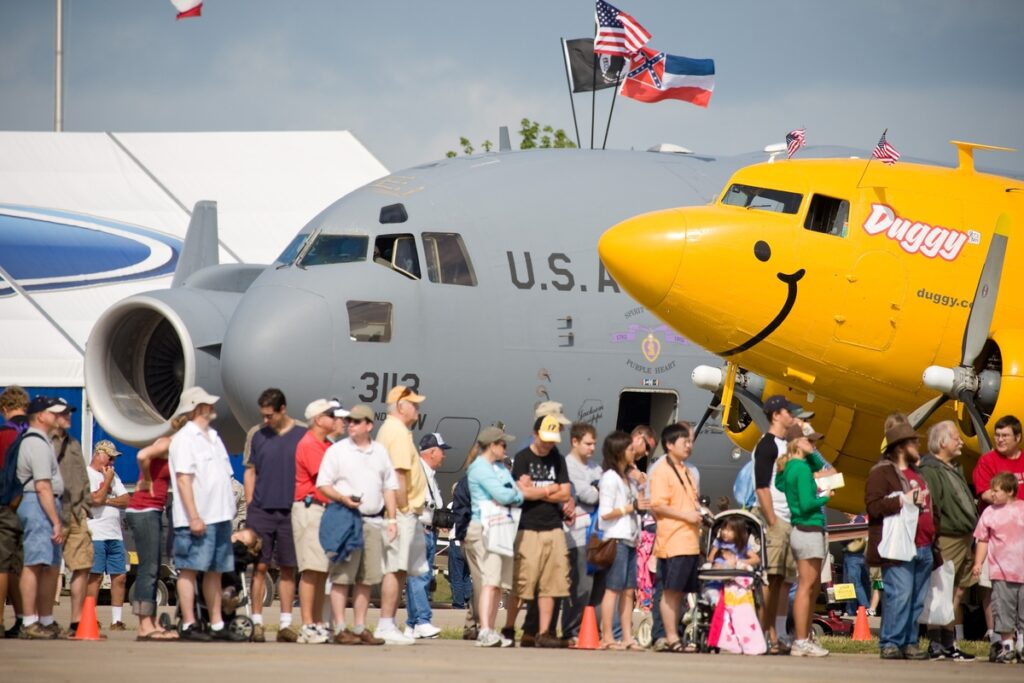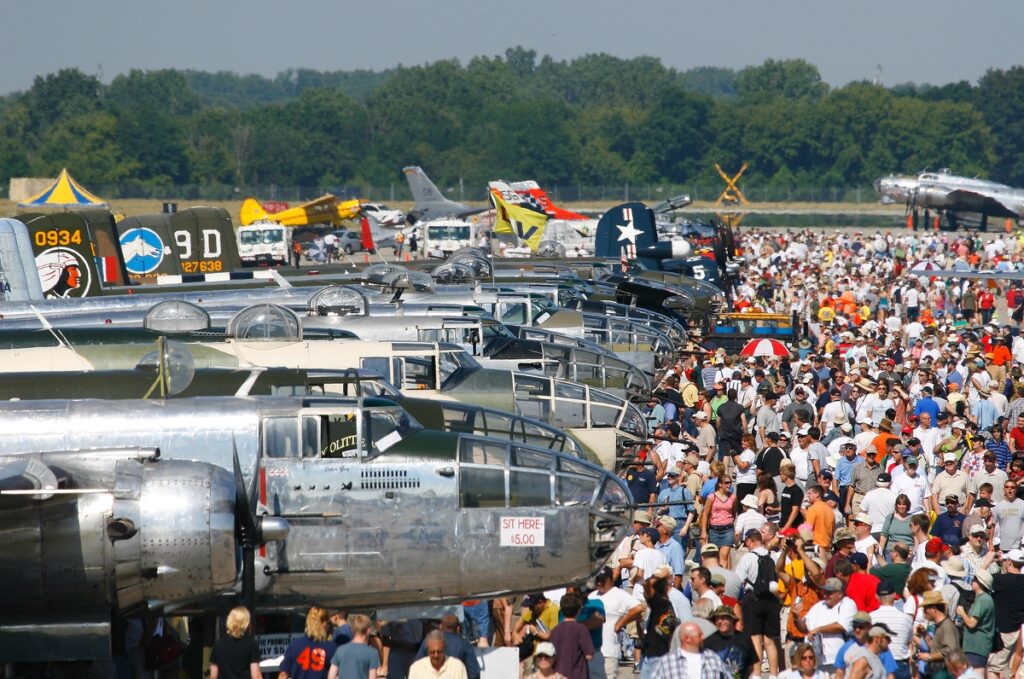By Mike Berriochoa
Praise the people who have the vision and courage to walk out onto an empty tarmac and imagine producing their first air show. These are the people who are the future of our industry. They bring with them the ambition, the spirit and the commitment to achieve their goal of a sky filled with airplanes and a ramp filled with displays…the very same people who eventually learn what so many others have already learned: that they don’t know what they don’t know. The pitfalls are many, the learning curve is steep, and the outcome can sometimes be uncertain. Fortunately, as others before them have, they find ways to overcome the challenges, go forward, and do good things for their communities.
 Few challenges for first-timers are more daunting than finding and securing military static displays. If the organizer isn’t familiar with how the military does things, getting assets to show up can be a confusing maze of paperwork, phone calls, and logistical headaches.
Few challenges for first-timers are more daunting than finding and securing military static displays. If the organizer isn’t familiar with how the military does things, getting assets to show up can be a confusing maze of paperwork, phone calls, and logistical headaches.
Military support, of course, starts with paperwork. That means properly filling out the Request for Military Aerial Support, better known as DD Form 2535 (Google DD Form 2535 to find it), and submitting it by the deadline shown on the form. Failure to complete the form correctly will result in it being bounced back. And, depending on the timing of that bounce back, the show risks getting no military support at all.
But successfully submitting the form is not the end of the process. “It’s only the beginning,” says Chris Ash who has been involved with the air show at the Alliance Fort Worth Airport in Fort Worth, Texas since it began. “Once the forms are filed, it’s time to get down to the details. I always advise any first-timer to start by finding out what your airport can accept. There is no point trying to bring in a C-17 if your runway isn’t wide enough or if your ramp can’t hold up the load,” he said.
From there, it’s a matter of tracking down the individual aircraft. “You can’t wait for the military to contact you. You have to be proactive. There are active duty military bases in every part of the country, and I recommend calling the public affairs office at each base. Talk to the head of the office, find out what kind of aircraft are there and how to reach the squadron schedulers, because those are the people who control which airplanes go where,” Ash said.
Because of budget constraints, force reductions, and operational requirements, the active duty units are not as able to support air shows as they once were. But National Guard and reserve units are attractive options because they have most of the same planes as active-duty units, and their pilots need to fly to maintain currency. And air show fans don’t really care where the airplanes come from. “Finding guard and reserve units isn’t hard because almost every state has one, and an internet search will usually locate them,” said Ash.
 A rule of thumb when you want a military asset is that, if you don’t ask for it, you won’t get it, so don’t hesitate to push the envelope. In the early 1980s, Jackie Ballard ran the Rotary Club Air Fair at Paine Field near Seattle. She kept pushing for a then-top-secret SR-71 for a static display. Her request was turned down every year, not only because of the secrecy surrounding the airplane, but because of the special fuel and other logistics requirements to support it away from its home base. But she made air show history one year when the right people were in the right place in the Air Force to approve the request, and her show became the first civilian show in the country to host an SR-71. That broke down the barriers and the “Sled” started showing up at a number of civilian shows in the U.S. and Canada for several years thereafter.
A rule of thumb when you want a military asset is that, if you don’t ask for it, you won’t get it, so don’t hesitate to push the envelope. In the early 1980s, Jackie Ballard ran the Rotary Club Air Fair at Paine Field near Seattle. She kept pushing for a then-top-secret SR-71 for a static display. Her request was turned down every year, not only because of the secrecy surrounding the airplane, but because of the special fuel and other logistics requirements to support it away from its home base. But she made air show history one year when the right people were in the right place in the Air Force to approve the request, and her show became the first civilian show in the country to host an SR-71. That broke down the barriers and the “Sled” started showing up at a number of civilian shows in the U.S. and Canada for several years thereafter.
Ash cautions first time shows that some squadrons like to send two aircraft as part of a training mission. But others may try to take advantage of a show and send three or four. “You don’t need more than two of any type of airplane on your ramp and you have the right to negotiate with a squadron,” Ash said. “You don’t have to accept everything they offer.”
Another reality when it comes to military static displays is that not all of them are going to show up. “I plan on ten to fifteen percent no-shows due to maintenance issues or changes in operational commitments. That’s normal, so don’t take it personally,” Ash said. The upside of losing displays is that shows can avoid the cost of hotel rooms and rental cars for the crews. The downside is not knowing which ones aren’t coming, often until the last minute, and having to spread out the displays that do come to fill the gaps.
Ash says you don’t have to rely on modern military aircraft to have meaningful displays. Air show fans love warbirds and Ash says they are easy to find simply by Googling the Commemorative Air Force and other flying museums and warbird collectors. “The CAF can usually direct you to warbird owners within your region who would be interested in bringing their airplanes,” he said. And he urges first-timers to get on the phone to any aviation museum in the region because many have airplanes they can send, usually for the cost of fuel and a hotel room or two, or know people who own them.
 Ash also advises that, when contacting both military and civilian organizations for displays, be sure to find out if they need any special equipment or supplies. “Some might need a unique tow bar that you may not have. Others may need a particular grade of oil. If it is beyond your means to provide for them, you can ask them to bring what they need or ask for their help in locating what they need. Ultimately, you have to decide if the struggle and expense of meeting those special needs is worth having them on your field,” Ash said.
Ash also advises that, when contacting both military and civilian organizations for displays, be sure to find out if they need any special equipment or supplies. “Some might need a unique tow bar that you may not have. Others may need a particular grade of oil. If it is beyond your means to provide for them, you can ask them to bring what they need or ask for their help in locating what they need. Ultimately, you have to decide if the struggle and expense of meeting those special needs is worth having them on your field,” Ash said.
Ash also reminds first-timers that not all displays need to be military airplanes. “Find the strength in your community and capitalize on it. Are there kit aircraft companies nearby? Are there aircraft maintenance schools nearby? Are there local manufacturers and other local industries that would like to set up displays? Car clubs are another good option. It doesn’t always have to be about aviation. Just use your imagination,” Ash said.
Once military units and other displays are committed, a new challenge arises, which is communications. “I’m a mother hen. I make the initial contact, then follow with an email, then contact them again three months out as a reminder, then remind them again one month out,” said Everett Gibson, who has been securing static displays for the Wings Over Houston show for several decades.
“Frequent contact significantly reduces the number of no-shows. A week out, I contact the mission coordinator to make sure they are still coming and that we have all of the assets they need or that they can bring whatever they need with them. I also discuss their arrival time and departure time, so we are all clear about what they can expect and what we can expect. It’s a lot of effort, but it pays off,” he said.
Prior to the show, Gibson sends each mission coordinator a map of the field, showing where each aircraft will park so that they have a big picture concept of the display area. “We provide a follow-me cart when they arrive and lead each aircraft into position based on the map that we provided,” he said.
One exception is helicopters. Gibson will not allow helicopters to park themselves on the ramp due to FOD issues. “I make it clear that they are to bring wheels and tow bars for their particular birds. They will be directed to land on a hard surface away from the display area and will be towed to their parking spot,” he said.
 Gibson prefers to schedule arrivals, if possible. Parking them haphazardly as they come in is not a wise option. “I want the large airplanes like a C-17 or B-52 on the ramp and in place on Thursday before the show. I’ll accept something the size of a C-130 on Friday morning, but that’s when I cut it off in order to move smaller planes in and around them,” Gibson said. “As you bring each airplane in, remember you have to get it out and — if they have to leave early — work that in advance and park them accordingly.” Gibson said there have been times when he has held up to four airplanes on a taxiway while he parks them in the correct sequence.
Gibson prefers to schedule arrivals, if possible. Parking them haphazardly as they come in is not a wise option. “I want the large airplanes like a C-17 or B-52 on the ramp and in place on Thursday before the show. I’ll accept something the size of a C-130 on Friday morning, but that’s when I cut it off in order to move smaller planes in and around them,” Gibson said. “As you bring each airplane in, remember you have to get it out and — if they have to leave early — work that in advance and park them accordingly.” Gibson said there have been times when he has held up to four airplanes on a taxiway while he parks them in the correct sequence.
Gibson said pathways always need to be maintained for all military aircraft in case they get called out during the show. Such callouts are rare, occurring more often with Coast Guard units that get called out for search and rescue missions. “We also had this happen to us once with a hurricane hunter, and we were able to deal with it smoothly because we planned for it,” he said.
Because shows ask military personnel to give up their weekends to attend a show, hospitality and organization are key if you want them to come back. “Fully eighty percent of our assets are flown in by crews that have been here before because they appreciate the coordination and our attention to detail. If you treat them right, they will return, and that makes planning a lot easier for next year’s show,” Gibson said. And he noted that word gets around quickly in the military if shows mess up.
“As schedules firm up, I prepare information packets for each air crew. This includes maps of the field, maps of the area, show schedules, social event information, visitor attractions, locations of restaurants, and other information about our area. I provide vehicle passes, provide a separate parking area for air crews and try to accommodate families who may come to the show,” Gibson said.
Some visiting aircrews like to sell their squadron memorabilia as fund raisers and Gibson says they will provide tables and chairs for that, as well, when asked.
Positioning displays on the ramp isn’t exactly rocket science, but there are ways to make it easier than drawings on a piece of paper. Canadian air boss David White has developed a novel technique combining the Google Earth software with Photoshop. “It’s a technique that I learned from a member of the Snowbirds team for laying out the boxes and marking the center points. When he showed it to me, I realized I could use it for laying out my ramps,” White said.
Once White knows which airplanes are coming to a show, he can use the web to find images of each aircraft. “I can use Photoshop to make a transparency of the airplane and scale it up or down according to the scale of the Google Earth photo I’m using,” he said.
White does this for each display, whether it is an airplane or some other type of display, and can easily move them around on the digital map until they all fit. It’s quick, easy and very portable. “Most shows use drawings. When something changes, for whatever reason, the layout has to be redrawn. Using a laptop or tablet at the show site, I can make changes instantly. And I can send digital copies of the layout that can be opened on a smart phone to anyone who needs it without having to send huge graphic files,” he said.
And the best part of using Google Earth, White said, is that it’s free and can easily be imported to a PowerPoint display. “I’ve used this technique to put 75 airplanes on the ramp at Cold Lake and they all fit. I probably could never have done that standing on the ramp and guessing where things should go,” he said.
While learning to use Photoshop may be a challenge, the long-term rewards make it worthwhile because — once you’ve created a transparency of a particular airplane — it never needs to change and can be used for something close to forever. “I have a transparency of the Snowbirds, for example, and I can use it no matter where I’m staging an air show. I know exactly how much space those eleven airplanes take up while parked. Wing tip to wing tip, nose to tail, that dimension never changes,” says White. “I’m proof that old dogs can learn new tricks.”
There was a time in the air show industry when show organizers held their tricks and techniques closely. Rarely would they share what they knew, making first-timers learn everything on their own. Those days are long gone, fortunately, and there are now multiple resources available to ICAS members simply for the asking. And while first-timers still may not know what they don’t know, they at least have the opportunity to ask experienced organizers to help them figure it out.
(Note: Chris Ash, Everett Gibson and David White were panelists “Static Display Acquisition and Lay-Out: New Challenges, New Opportunities, New Tools,” a break-out education sessions during the 2019 ICAS Convention in Las Vegas.)








